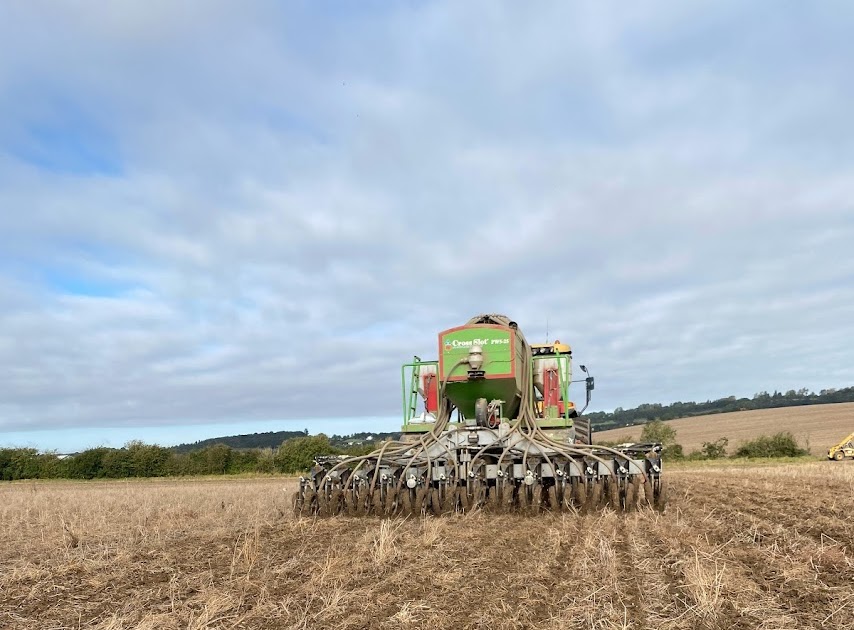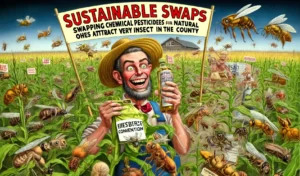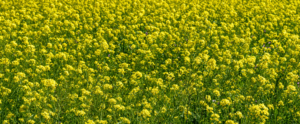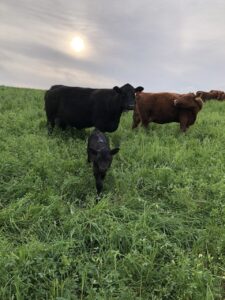Much as though the weather has been pretty good, I have held back on sowing a different block of wheat. The variety, Mulika, is happy to be seed-drilled in either Winter or Spring. Consequently if I can’t get it in this side of Christmas, there is no worry establishing it later.
There is a potential issue with Spring sown cereals though: one that has bitten pretty hard for harvest 2021 (currently in the grain store). That issue is the fungal disease, ergot. Ergot looks like black infected curled-up toenails in the wheat sample (lovely analogy I know!) and is poisonous if ingested. It often occurs if the weather is especially wet at the time in Spring when the wheat flowers. Spring wheat tends to flower at the same time as when spores from ergot are floating around, and so it is easier for spring varieties to be infected.
It is not the end of the world if the crop gets hit with ergot. But it does involve more expense and messing around. The ergot must be removed before the crop is sold, which requires a snazzy piece of kit called a ‘colour sorter’. There are only two mobile lorries in the UK with this machine on – not ideal when you have 250 tonnes of high quality wheat which is unsaleable until cleaned. But hopefully come December that will be done!
In the first week of October I managed to take a morning to visit Quentin Edwards and his Cools Farm herd of cows near Salisbury. I visited him previously when I had been on the look for a bull and liked his stock, so I was travelling back up to see ten yearling heifers that he had for sale. This will be the final cattle purchase before I close my herd (or that is the plan at least).
 |
Quentin’s beautiful cows
|
 |
| The young heifers have a lovely shape, and a wonderful temperament (most important!) |
Closing the herd means that I will not be importing any more cattle to my farm, and will just work with what I have. The only exception will be changing my bull every three years, which will be performed under strict quarantine and testing protocols. The point of closing a herd means that you shouldn’t be importing any new disease, with the aim of avoiding the requirement to vaccinate. I liked Quentin’s cows and bought the cattle, on the proviso that their bloods were tested for cattle diseases BVD, IBR, Johne’s and neospora. I wish I’d understood the importance of this before purchasing my first in-calf cows last year when I imported neosporosis to the farm and lost two calves to abortion.
Quentin has never had issues with abortion, yet much to his surprise four of the heifers came back with a positive result for neospora. The hunt runs through Quentin’s farm, as too do some well-trodden walking routes, so the chance of infection from dogs is unfortunately high. I was gutted not to get these four animals, and for Quentin too (who is now planning on testing his entire herd and culling those who are positive), but I’m pleased to know that the animals that arrive have a clean bill of health. They are due to arrive at the start of November and will go to the bull in July with the rest of my herd.
The end of October saw my cows needing to be moved off the conservation grazing on the Essex Wildlife Trust Fobbing Marshes and back onto mob-grazing. I don’t have time for daily moves currently (unfortunately), so I will be moving approximately once a week. Since I was moving the cows to new grazing, I thought it a sensible time to run the cows through the crush in order to check who was in calf. We also took bloods on all the adults in my existing herd to test for the aforementioned diseases. At least that way I’ll know what I have in the herd and can manage appropriately and cull as required to end up without any disease (hopefully!). As with anything new, if I were to buy a new herd again I would do things very differently! But I have learned a lot in a year.
 |
| One of the first cows through the crush |
Mia from Westpoint Farm Vets did the pregnancy testing, and a final year student from Surrey Vet School (Ellie) also came along to get more experience taking bloods from cows (which is done by lifting the tail high in the air and using a vacuum tube to extract blood from the tail vein on the underside of the base of the tail). It also gave me the opportunity to try using a different style of cattle handling, utilising something called a ‘Bud Box’ as a system to naturally flow the cattle down the race and into the crush, keeping the cows calm and stress free. If you are interested it is worth looking up on YouTube. And although my version of it needed a few tweaks, I was very pleased by how it functioned.
 |
| Mia inserts her arm into the cows’ rectums, and uses a scanner internally. This then displays on her fancy goggles such that she can detect the calf in the uterus |
 |
| It’s a glamorous job… |
Twelve of my cows had run with Kestrel the bull this year. And five of those were neospora positive (determined by testing last February). In theory those five had a 50:50 chance of being in calf. So I am very pleased that only one, cow 070, was not in calf, and I am expecting eleven new lives on the farm from mid-February onwards. I am also pleased that Kestrel performs as well as he looks! There is still a greater chance that the neospora-positive cows may abort, but that becomes much less likely in a month to six weeks time. So fingers crossed! Hopefully this time next year we will have a herd of 55 animals, with 31 in calf. That would be a good result starting with just eleven at the end of 2020!
 |
| Ellie taking bloods |
 |
| Off the conservation grazing and back on diverse herbal leys |
Mia also had the less than desirable job of surgically castrating my youngest bull calf, Halibert. With him being so little, we were happy that the head yolk on the cattle crush at least went small enough to hold his head securely, and we could put a pallet in the crush to narrow it. Mia then stood to one side to stop him moving whilst I held his tail up out of the way standing behind him. Once restrained he fully calmed down, and Mia could administer a local anaesthetic. The operation was swift (although naturally uncomfortable to witness as a man!).
 |
| Unfortunately I got stomped on during handling the cattle… |
 |
| …thankfully I escaped it being broken. But it didn’t half swell up. I actually wrote this blog whilst in Basildon Hospital A&E awaiting an X-ray! |
As a little bit of something different, the middle of the month saw me travelling down to the Cotswolds to Honeydale Farm, home to FarmEd (owned by a good friend, Ian Wilkinson, who also owns Cotswold Seeds – where all my gorgeous diverse herbal leys are from!). FarmEd is a beautiful demonstration farm with an incredible education centre at its heart, teaching about holistic farm management, regenerative
farming, etc.
I was there because I am helping Nikki Yoxall (who I visited near Inverness last month) to develop an education course in agroecology. There have been a number of group Zoom calls through the year building up to this, but it was great to have an in-person session with eight of us really trying to hone the syllabus. Something entirely new to me, but very close to my heart.
 |
| Formulating the ‘Introduction to Agroecology’ course. Definitely not the norm for me! |
I was grateful to have the opportunity whilst there to sit down with Ian in the evening and have an in-depth chat about my business and what I am attempting to do. Ian is a generation older than me, but we share very similar passion, drive and determination for the same things. Being able to candidly talk though my business was exceptionally valuable, especially given the lack of face-to-face meetings of late.
I’m hoping the next month will see us complete a good length of fencing on the farm; ring fencing the holding so I can feel happy that my cows won’t end up on the road. Perhaps if I’m lucky, maybe we’ll manage to establish the Mulika wheat and winter beans too.
















